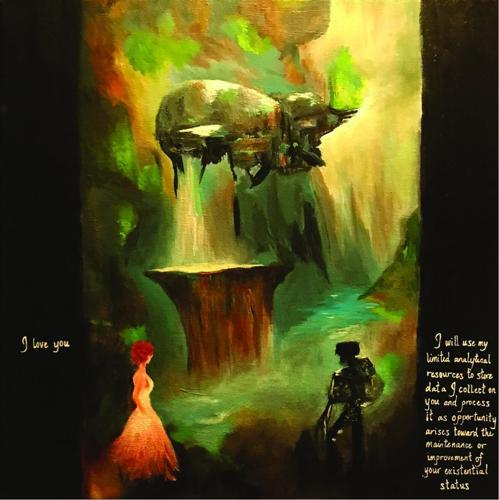For nearly a year, Henry Obeng, a graduate student at the University of Wisconsin-Madison, has created artwork using artificial intelligence alongside computer science student Sheriff Issaka.
The two international students met through the African Students Association and Ghana Association of Madison, where Obeng learned Ghanaians in the city were facing difficulties obtaining legal status as immigrants.
Hoping to spread awareness of the issue while also protecting the immigrants’ identities, Obeng recreated their portraits with Issaka, who programmed AI to make new faces based on the features of those who are undocumented. The images will be on display through February at the university’s Discovery Building, 330 N. Orchard St., for the Data Science Hub’s “Art Meets Science” exhibit.
“I’m at the stage in making this where we can collaborate with different disciplines. We can have ideas from different perspectives, combining them to make artwork,” Obeng said of the photo series, which they called “We Exist.”
As part of the process, Obeng first captured photographs of the subjects, which Issaka then used to create computer-generated faces that do not exist. Obeng later printed them on secondhand clothing from local stores that the immigrants frequent, providing a color wash effect symbolizing the concept of “illegal alien.”
The exhibit, which will be celebrated as part of the annual Data Science Research Bazaar on Feb. 2 from 5 to 6 p.m., will also feature visual art by others in science fields at the university.

Henry Obeng and Sheriff Issaka created a series of computer-generated portraits for a series called "We Exist," part of the Data Science Hub's "Art Meets Science" exhibition.
A unique way to view Earth
Rich Kohrs, who works in satellite data services at the Space Science and Engineering Center, will showcase his educational art, called “High Noon From Geostationary Orbit.”
Using five geostationary satellites from thousands of miles above the earth — including one from Japan, two from the United States and two from Europe — Kohrs created color images of global weather patterns taken at local noon time. His artwork includes a global composite stitching together data from over 250 images at local noon, covering a 24-hour period.
“There are significant math skills required, especially trigonometry, to create the composites,” Kohrs said. UW-Madison is the only place in the world that creates these images of local noon.
“While the composites are not used for pure science, they are really pretty pictures and allow great educational opportunities to illustrate global weather systems and other seasonal events,” Kohrs said.

"High Noon From Geostationary Orbit" is a composite image by Rick Kohrs, who has worked at UW-Madison for 32 years.
Other organizations have used similar techniques with geostationary satellites to display color images of planets. In one famous example, NASA created the “Big Blue Marble” photo, a detailed, true-color depiction of Earth.
The vibrant photos are especially intriguing to children and can “plant seeds into their heads to get them interested in science,” Kohrs said. But he hopes people of all ages will take away “the awe-inspiring Earth that we can see from geostationary satellites.”
Visualizing data security through art
Julia Ramos, a UW-Madison alum, has several paintings featured in the exhibit. She said the art is inspired by accelerated learning and communication, as well as the data-centric future that society is veering toward.
“I’m very interested in semantics (the study of meaning), categorization and symbolism,” Ramos said. “These are tightly interrelated concepts and very much relevant to both art and data science.”

"Girl and Robot" uses the idea of love and romance to share a larger message on sharing and protecting data in communities.
In “The Analyst” and “Girl and Robot,” the artworks depict sharing and protecting data in communities, while also showing the idea of love and romance. Considering data is a powerful tool, Ramos said, the art reveals how those who hold this technology can “drive a lot of influence” over others. “We ought to take the trust that this requires seriously.”
“From Data Signal to Wisdom" also prompts viewers to consider emerging data science technologies. The piece, which shows a panel of four scenes, takes the audience into “a futuristic world centered around accelerated learning and individual meaningfulness.”
“The psychology of how we process sensory data into usable information, knowledge and wisdom across important purposes is explored from a number of angles across all three pieces,” Ramos said. “I hope my pieces and the conference overall brings more awareness and thought to the ethical implications of data privacy and data sharing in communities.”
Using math in photography

Lucy Kuo, a self-taught photographer, captured this image on a point-and-shoot camera when she was in high school.
Lucy Kuo, a junior studying computer science and economics, will display a photograph she took in high school titled “Summer,” which shows flowers in bloom at Millenium Park in Chicago.
Kuo said she uses photography as a creative outlet, but also employs mathematical concepts in her artwork to capture the symmetry and geometric lines found in her surroundings.
“It’s interesting for me as a STEM major — which is normally focused on data and quantitative things — to step outside of that,” she said. “I try to depict some sort of emotion through my photos, which I don't normally get the chance to do with coding.”
She hopes the exhibit will show people how art and science can blend together.
“I feel like with technology, we’re losing the creativity and the humanity side of it,” she said. “You can have different perspectives, bridging different concepts and fields with art.”










